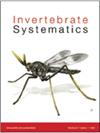来自厄瓜多尔的座头蜘蛛:关系、原体“膨胀”和生殖器不对称(蜘蛛目:背蛛科:背蛛科)
IF 1.9
2区 生物学
Q3 EVOLUTIONARY BIOLOGY
引用次数: 0
摘要
摘要南美洲Mecolaesthus Simon属的雄性蜘蛛,1893年,其特征是背部“膨胀”的前体或驼峰。在这里,我们描述了来自厄瓜多尔的第一个代表。分子序列数据的系统发育分析表明,新物种是亚马逊-西印度分支的一部分。这个分支是否是“真正的”(委内瑞拉北部)Mecolaesthus的姐妹尚不清楚。这两个支系分布在不同的主要新热带生物地理区域。与之前的分析相比,我们对Mecolaesthus及其相关属的系统发育再分析大大扩展了分类群样本(从9种增加到46种,代表属的“委内瑞拉分支”),但关于Mecolaesthus的单系性仍然模糊不清。此外,我们提供了第一个独特的假体“膨胀”的微计算机断层扫描(micro -CT)数据,显示这些“膨胀”与插入腿髋部的肌肉紧密包裹,主要是腿2和3。雄性(而非雌性)的腿长与体型呈负相关,这在凤尾科中是非常不寻常的。我们预测,在Mecolaesthus中,雄性之间的战斗依赖于2号腿和3号腿的有力运动,而不是用1号腿来评估对手的体型。最后,我们记录了四个新物种中的三个雌性和M. putumayo Huber, 2000(其中雌性是新描述的)的结构性生殖器不对称。这是已知的第四个凤梨科结构不对称的病例。ZooBank: urn: lsid zoobank.org:酒吧:3110 bcd6 ba65 - 45 - e2 a758 - 71 f2767bd6e4本文章由计算机程序翻译,如有差异,请以英文原文为准。
Humpback spiders from Ecuador: relationships, prosoma ‘inflation’ and genital asymmetry (Araneae: Pholcidae: Mecolaesthus)
Abstract. Males of the South American spider genus Mecolaesthus Simon, 1893 are characterised by a dorsally ‘inflated’ prosoma or hump. Here we describe the first representatives of the genus from Ecuador. A phylogenetic analysis of molecular sequence data suggests that the new species are part of an Amazonian-West Indian clade. Whether this clade is sister to ‘true’ (northern Venezuelan) Mecolaesthus or not remains unclear. The two clades occupy different major Neotropical biogeographic regions. Our phylogenetic reanalysis of Mecolaesthus and related genera greatly expands the taxon sampling compared to previous analyses (from 9 to 46 species representing the ‘Venezuelan clade’ of genera) but remains ambiguous regarding the monophyly of Mecolaesthus. In addition, we present first micro-computed tomography (µ-CT) data of the unique prosoma ‘inflation’, showing that these ‘inflations’ are tightly packed with muscles inserted at the leg coxae, mainly of legs 2 and 3. Male (but not female) leg length is negatively correlated with body size and this is highly unusual in Pholcidae. We predict that male–male fights in Mecolaesthus rely on powerful leg movements of legs 2 and 3 rather than on using legs 1 to assess the opponent’s body size. Finally, we document structural genital asymmetry in females of three of the four new species and in M. putumayo Huber, 2000 (of which the female is newly described). This constitutes the fourth known case of structural genital asymmetry in Pholcidae. ZooBank: urn:lsid:zoobank.org:pub:3110BCD6-BA65-45E2-A758-71F2767BD6E4
求助全文
通过发布文献求助,成功后即可免费获取论文全文。
去求助
来源期刊

Invertebrate Systematics
生物-动物学
CiteScore
4.30
自引率
9.10%
发文量
35
审稿时长
>12 weeks
期刊介绍:
Invertebrate Systematics (formerly known as Invertebrate Taxonomy) is an international journal publishing original and significant contributions on the systematics, phylogeny and biogeography of all invertebrate taxa. Articles in the journal provide comprehensive treatments of clearly defined taxonomic groups, often emphasising their biodiversity patterns and/or biological aspects. The journal also includes contributions on the systematics of selected species that are of particular conservation, economic, medical or veterinary importance.
Invertebrate Systematics is a vital resource globally for scientists, students, conservation biologists, environmental consultants and government policy advisors who are interested in terrestrial, freshwater and marine systems.
Invertebrate Systematics is published with the endorsement of the Commonwealth Scientific and Industrial Research Organisation (CSIRO) and the Australian Academy of Science.
 求助内容:
求助内容: 应助结果提醒方式:
应助结果提醒方式:


